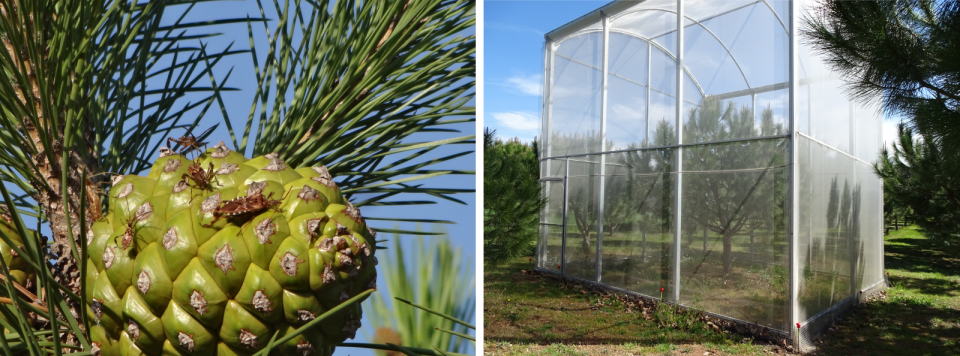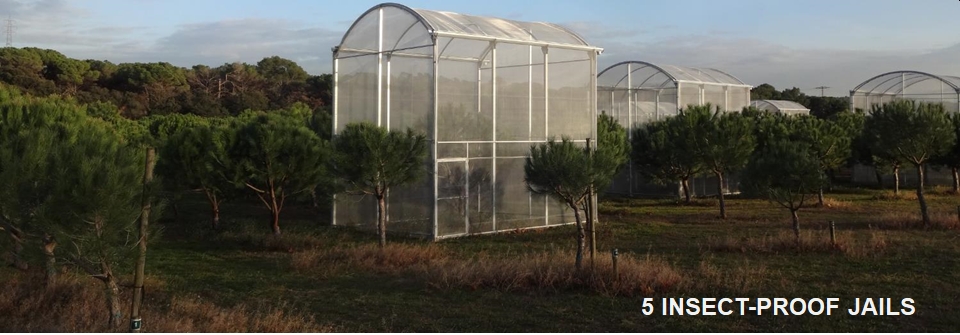
Some experiments conducted at the Institute of Agri-Food Research and Technology of Catalonia (IRTA), aimed at evaluating the productive capacity of Stone pine clones from different Spanish provenance regions (PR) under Leptoglossus occidentalis Heideman attack, are presented. This pest is severely affecting Stone pine stands in the Iberian Peninsula, hence, identifying genotypes less susceptible to L. occidentalis attack is an important line of research in this area.
In the current context of climate change, the intensity and recurrence of droughts has triggered stress conditions that reduce the defensive capacity of Mediterranean forests. This tree weakening and the increased arrival of harmful exotic organisms triggers the emergence of pests and diseases. For Pinus pinea L., the Western conifer seed bug (L. occidentalis) is a recent pest in Spain, the incidence of which has decimated pine-seeds production in just 5 years. To the date, no biological control has been developed against it, and the most promising line of research involves identifying pines with greater resistance to seed predation.
In a field trial planted between 2009-2011, the incidence of L. occidentalis was evaluated in 64 P. pinea clones from four regions grafted onto the same species. In 2014, a subsample of 5-10 trees was individually protected with insect-proof coverage. Conelets, cones and pine nuts harvested were counted annually. The main results were: a) protection led to a 2.8 to 3.5-fold increase in pine nuts production . Losses were attributed to conelet abortion and/or predation of pine nuts in mature cones; b) at clonal level, cone harvest was positively correlated with conelet onset three years before and with reduced abortion and seed predation during cone development; c) there were no significant effect of PR, although ‘Coastal Catalonia’ showed the lowest initial conelet onset but also experienced the lowest cone and seed predation, balancing the final harvest.
Given that initial conelet number at clonal level was positively correlated with pine nut harvest three years later, it is recommended that clones selected combine high onset of conelets together with reduced cone losses during the three years of cone development, in order to maximize production in grafted plantations under L. occidentalis attack. The local provenance region, ‘Coastal Catalonia’, showed reduced cone losses under the trial conditions. These results should be corroborated under different environmental conditions before recommending a preferent use of any provenance.
This line of research provides important information for the selection of genetic material under a forest health emergency caused by an invasive pest. However, the main weakness of this strategy is the length of time required to solve the problem, and its high experimental costs. Additionally, these sorts of genetic experiments provides insights into the productive behavior of different Stone pine clones, thus allowing the defensive mechanisms of pine trees against seed pests and their genetic variation to be better understood. Such research may also help to disentangle potential interactions between such mechanisms and the insect demography and damages.
Future lines of research at IRTA will be focused on the development of designs for grafted P. pinea plantations using clones selected for their high production and/or reduced susceptibility to L. occidentalis. Furthermore, the defensive mechanisms that provide resistance against the invasive pest will be deeperly studied, as will the relationship between insect attack/demography and the heterogeneous and synchronic seeding patterns of the tree, known as masting.
Raul de la Mata Pombo, raul.delamata@irta.cat, www.irta.cat
Anna Teixidó, anna.teixido@irta.cat, www.irta.cat
Neus Aletà, Neus.Aleta@irta.cat, www.irta.cat
Further information
de la Mata R, Teixidó A, Aletà N (2019). Clonal variation in susceptibility to Leptoglossus occidentalis in grafted plantations. Wild nuts & berries iNet Interregional Workshop ‘Wild harvest in time of new pests, diseases and climate change’, Palencia, Spain, 12-14 June 2019. INCREdible Thematic Network on Innovation in Mediterranean Non-Wood Forest Products.
(c) Raúl de la Mata

Insect-proof cages (c) R. de la Mata
